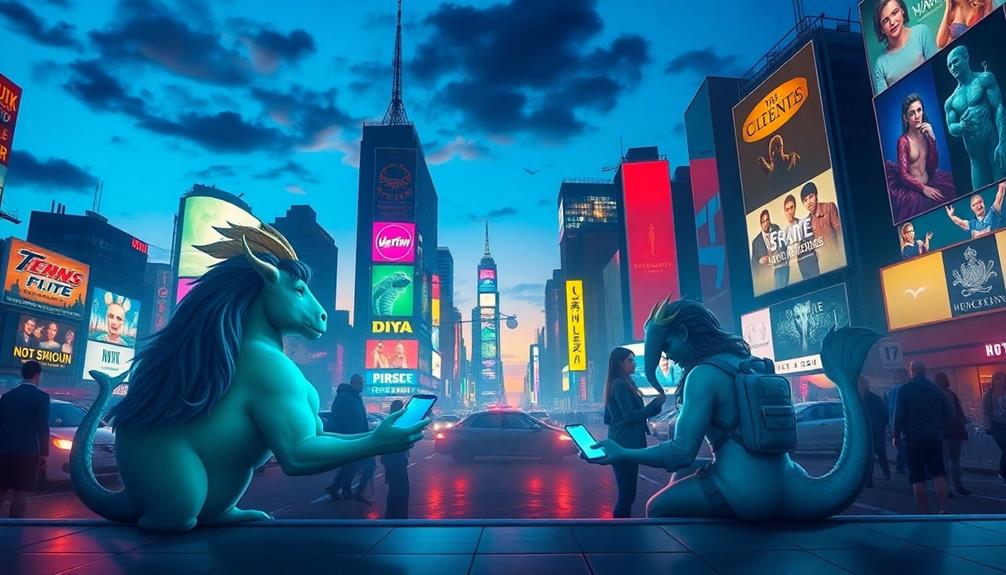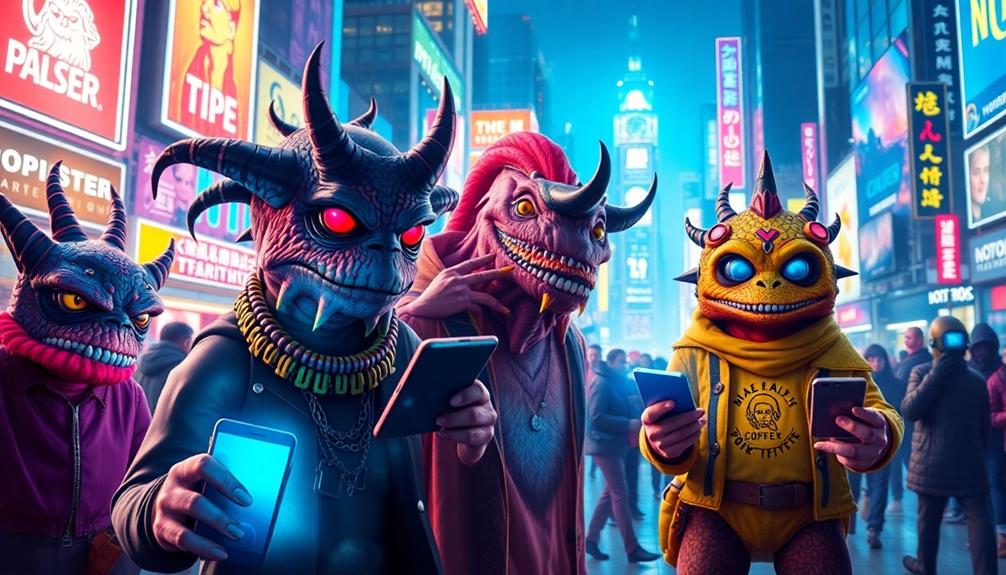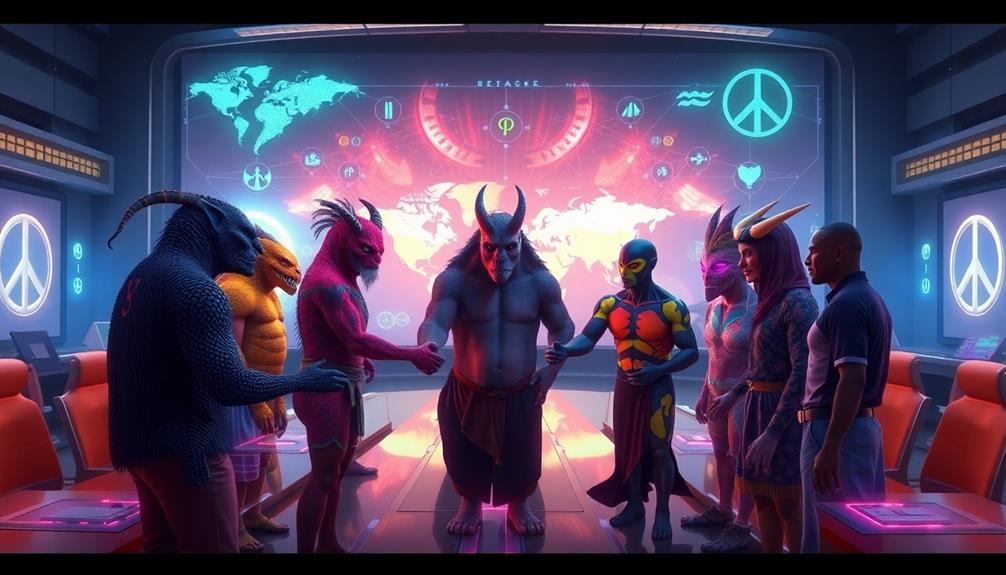If monsters fully integrate into the digital age, they'll redefine our fears. You'll see entities like Slender Man and Momo thrive online, blending fiction with reality. These digital beings reflect societal anxieties about technology and youth behavior, creating modern folklore that shapes collective consciousness. The psychological impact can lead to increased anxiety and social withdrawal, especially among teens. As surveillance technology grows, concerns about privacy and personal freedom will heighten. Engaging with these monsters transforms our culture, sparking important conversations about ethics and storytelling. Discovering their deeper implications can reveal even more about our digital landscape.
Key Takeaways
- Digital monsters could evolve into powerful symbols reflecting societal anxieties about technology and surveillance, shaping cultural narratives and collective fears.
- The integration of monsters into digital platforms might amplify online folklore, fostering community engagement and shared storytelling among users.
- Psychological impacts could intensify as digital entities contribute to heightened anxiety and paranoia, particularly among vulnerable populations like teenagers.
- Ethical dilemmas may arise regarding content moderation and mental health, necessitating responsible storytelling practices to mitigate harmful effects.
- Surveillance technology could intertwine with digital monsters, further complicating issues of privacy and autonomy in an increasingly monitored society.
Historical Perspectives on Digital Monsters

Digital monsters have emerged as a fascinating reflection of our societal fears, particularly in the context of technology's pervasive influence. From the chilling tales of Slender Man, born in 2009, to the viral Momo Challenge, these digital creatures illustrate how new technologies can shape and amplify our anxieties.
You might notice that these narratives often originate in online communities, where they evolve into modern folklore, deeply embedded in our cultural consciousness.
As you explore these digital monsters, consider how they tap into collective fears about technology's impact on behavior, especially among youth. The internet not only fuels the spread of these urban legends but also enhances their potency, allowing fears to resonate widely and quickly.
The phenomenon of Tulpa, highlighting how communities collaboratively create and shape these narratives, showcases the power of collective storytelling in the digital age.
Ultimately, these digital monsters serve as cautionary tales, reminding you of the darker side of new technologies and their potential consequences on society. They invite you to reflect on how culture adapts and transforms in response to the fears and anxieties that come with an increasingly digital world.
The Role of Surveillance Technology

Surveillance technology has permeated everyday life, transforming how individuals interact with their environment and each other. It's not just about security; it's become a tool for control.
You see it in face recognition technology (FRT), which poses significant risks of mass surveillance and privacy violations. As cyber threats increase, the importance of AI security grows, emphasizing the need for protective measures against misuse of such technologies. Advocacy groups like the Electronic Frontier Foundation warn against its use, especially by governments, as it often targets marginalized communities.
Take the Venezuelan government's extensive surveillance systems, for example. They monitor citizens during political unrest and elections, showcasing how digital monitoring suppresses dissent. This creates a sense of anxiety, almost like facing a three-eyed beast, constantly judging your every move.
In the U.S., while legal frameworks aim to protect your privacy in public spaces, the explosion of surveillance cameras raises serious concerns about civil liberties. Notable cases like Armendariz v. City of Colorado Springs highlight the struggle against invasive police practices.
The digital landscape has birthed metaphorical monsters, such as the Face Stealer, symbolizing the fear of lost identity and autonomy.
In this hyper-connected world, surveillance technology transforms into these Technological Monsters, threatening your freedom and individuality.
Psychological Impact of Digital Entities

Emerging from the shadows of online culture, viral entities like Slender Man have sparked a wave of anxiety and paranoia, particularly among teens. The psychological impact of these digital monsters is profound, often leading to heightened feelings of being watched or judged in online spaces.
With increased screen time, you might find yourself more exposed to horror narratives that can exacerbate fear and vulnerability, contributing to a decline in mental health.
As you engage with these stories, you may feel a sense of community, yet this interaction also risks normalizing fear and distrust. Studies show that the very concept of "believability" in online horror can blur the lines between fiction and reality, making it hard for you to feel safe in both digital and physical environments.
Additionally, these narratives reflect collective societal fears, highlighting issues of identity loss and the surveillance technologies that threaten personal freedom.
As you navigate this digital landscape, it's essential to be mindful of how these entities can shape your mindset and affect your well-being, potentially leading to social withdrawal and long-term psychological effects.
Cultural Myths in the Digital Age

In today's interconnected world, cultural myths are no longer confined to bedtime stories or local legends; they've evolved into powerful digital narratives that shape our collective consciousness.
Digital monsters like Momo and Slender Man serve as contemporary folklore, mirroring societal fears and anxieties that spread through social media and online platforms. These entities thrive on new technology, transforming into urban legends that capture our imagination and moral concerns.
As we navigate this digital landscape, it becomes increasingly important to maintain a positive energy that can influence our engagement with such narratives, allowing us to focus on the lessons they may offer about human behavior and creativity in the face of fear. By incorporating principles from Abraham's Business Success Principles, we can better understand how these myths reflect deeper truths about our society.
You might notice that the Slender Man phenomenon, born in 2009, even incited real-world violence, demonstrating how online narratives can influence behavior. Engaging with these myths in horror communities fosters a sense of belonging, as you and others share in the thrill and fear of the unknown.
Yet, as these cultural myths gain traction, they raise questions about their impact on youth behavior and safety. The Momo Challenge, for instance, highlights the darker side of our digital age, making it clear that some narratives won't simply go away.
Instead, they adapt and evolve, ensuring their relevance in discussions about societal fears and human creativity in this ever-changing digital landscape.
Ethical Considerations and Future Implications

Frequently, discussions around digital monsters highlight the ethical dilemmas they present, especially regarding mental health. As these characters gain traction, particularly among vulnerable populations like children, it's vital to address how they impact psychological well-being. The responsibility of content creators and platforms in moderating harmful narratives cannot be overstated.
Here's a snapshot of key ethical considerations:
| Ethical Consideration | Impact on Mental Health | Future Implications |
|---|---|---|
| Content Moderation | Reduces exposure to harmful narratives | Encourages safer online environments |
| User Consent | Guarantees users understand risks | Fosters trust between platforms and users |
| Data Privacy | Protects against feelings of surveillance | Enhances user autonomy and well-being |
As digital monsters evolve with AI and VR, ethical frameworks must also adapt. We need guidelines to regulate storytelling and mitigate fear while promoting positive engagement. Addressing these ethical considerations is essential not only for protecting mental health but for guaranteeing a responsible digital landscape that honors user autonomy.
Conclusion
So, as you scroll through your feeds, remember: those digital monsters aren't just lurking under your bed anymore; they're sliding into your DMs. Embracing the chaos of pixels and paranoia, you'll find that surveillance isn't just for your nosy neighbor; it's a collective hobby. Who needs traditional nightmares when you can have algorithm-driven anxieties? After all, nothing says "modern living" like being haunted by your own online presence. Cheers to the monsters—our digital companions in this absurd age!










